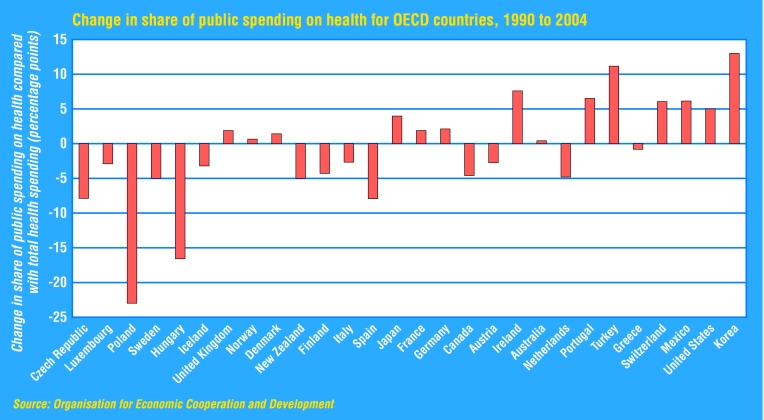Health spending has grown faster than gross domestic product in every country of the Organisation for Economic Cooperation and Development (OECD) except Finland in the past 15 years, new statistics show.
Figure 1.
Figure 2.
The OECD Health Data 2006, which was released by the international Paris based organisation at the end of June, is a comprehensive database of comparable health statistics with more than 1200 indicators for rich countries.
The data show that health spending across OECD countries averaged 7% of gross domestic product in 1990, but had climbed to 8.9% by 2004. Presenting the findings, the organisation warned that if current trends continue and the level of health care was to be maintained, governments would either have to raise taxes, cut spending in other areas, or make the public pay more from their own pockets.
The United States emerges as the country with the highest share of gross domestic product devoted to health—15.3%, up from 12% in 1990—although the bulk of this comes from the private, not public, purse. In second place comes Switzerland with 11.6%.
Among European Union countries, Germany devotes the most with 10.9% followed by France (10.5%) and Belgium (10.1%). The United Kingdom allocates 8.3%, the same as Hungary, and narrowly ahead of Spain (8.1%) and Japan (8%).
In most OECD members, the bulk of healthcare costs are financed through taxes. Throughout the whole zone, the average is 73%, but it is nearer 90% in Luxembourg, the Czech Republic, and Slovakia and about 85% in the UK, Sweden, Denmark, and Norway.
However, the proportion of health funding coming out of public, as opposed to private, funds has been reduced in countries that previously had a relatively high level—Poland (by 23.1%), Hungary (16.6%), and the Czech Republic (8.2%). In contrast, it increased in Korea (by 12.9%), Turkey (11.1%), Ireland (7.6%), and the UK (1.9%).
Supplementary Material
 Longer versions of these articles are on bmj.com
Longer versions of these articles are on bmj.com
The report, OECD Health Data 2006, is available at www.oecdbookshop.org.
Associated Data
This section collects any data citations, data availability statements, or supplementary materials included in this article.




